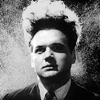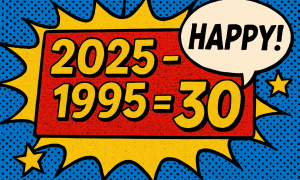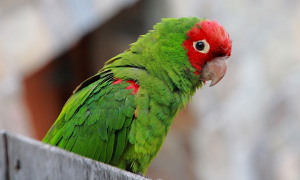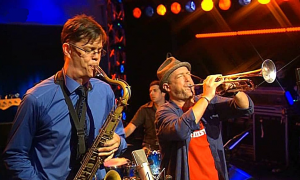Home » Jazz Articles » Genius Guide to Jazz » Farce-inatin' Rhythm
Farce-inatin' Rhythm
By the Be-bop era, jazz drumming had become as technically demanding as trying to undo a four-hook bra strap while driving a stick-shift.
Which probably doesn't mean what you think it does.
 This month, we're going to look at the rhythm section, the backbone of jazz that transforms a seeming morass of frenetic noodling into a seeming morass of frenetic noodling with a beat. It is the rhythm that is the primary animating force in jazz. It is the skeleton on which the flesh hangs. it is the roux that holds the gumbo together (to borrow a borrowed phrase). It is the crust of the pie, the rudder of the boat, the laces of the shoe. Do you understand the importance of the rhythm section now, or do I have to go through another five or six analogies?
This month, we're going to look at the rhythm section, the backbone of jazz that transforms a seeming morass of frenetic noodling into a seeming morass of frenetic noodling with a beat. It is the rhythm that is the primary animating force in jazz. It is the skeleton on which the flesh hangs. it is the roux that holds the gumbo together (to borrow a borrowed phrase). It is the crust of the pie, the rudder of the boat, the laces of the shoe. Do you understand the importance of the rhythm section now, or do I have to go through another five or six analogies? I thought as much.
For our purposes, we're going to consider the rhythm section to be composed of the bass and drums. We're also going to consider the Atlanta Rhythm Section a one-hit wonder from the seventies (Remember So Into You? Neither does anyone else). And while we're at it, we might as well go ahead and consider the lilies of the field. Why, you ask? Because the Bible says to, and who are you to question?
Now then.
 I'll spare you my usual rigmarole about how the history of the drum goes back to the most primitive man who probably used a bone to beat on a stretched skin and blah blah blah. Who can say when the art of drumming began? I can, for one. For my money, it began at Carnegie Hall in 1938, when Gene Krupa snapped his nervous bandmates out of their stage fright with a cacophonous drum break and helped usher jazz into a new era of respectability. It also began a long, proud tradition of erratic behavior by drummers.
I'll spare you my usual rigmarole about how the history of the drum goes back to the most primitive man who probably used a bone to beat on a stretched skin and blah blah blah. Who can say when the art of drumming began? I can, for one. For my money, it began at Carnegie Hall in 1938, when Gene Krupa snapped his nervous bandmates out of their stage fright with a cacophonous drum break and helped usher jazz into a new era of respectability. It also began a long, proud tradition of erratic behavior by drummers. In the early days of jazz drumming (Monday and Tuesday), the drum was little more than a timekeeper. A solid boom-chick boom-chick was pretty much all that expected from the drummer, leaving him free to pursue other interests. What set the jazz drummer apart from any other type of drummer in those days was his penchant for syncopation, which is the emphasis of traditionally weaker beats (the second and fourth beats, in common time, as opposed to the stronger first and third beats in the mainstream of Western music). It was said by moralists of that era that syncopation was a cause of immorality in young women, which we know today to be complete balderdash. But syncopation combined with a few well-placed glasses of wine at least gives a guy an even-money chance. I recommend Buddy Rich and a nice Shiraz.
As jazz drumming evolved, the freedom of jazz allowed the drum to evolve into an instrument rather than just a glorified metronome (home of the Vikings and Twins). Drummers began exploring the true musical potential of their instruments, which led to several ill-advised experiments. In 1948, famed drummer Philly Joe Jones' cousin Wilkes-Barre Willie Jones (from you-guessed-it) recorded an interpretation of Flight of the Bumblebee for jazz percussion, which Downbeat hailed as "completely unintelligible." Willie would later be vindicated by history, when that recording served as the inspiration for the Surfaris' Wipeout.
What this means is.
By the Be-bop era, jazz drumming had become as technically demanding as trying to undo a four-hook bra strap while driving a stick-shift.* Drummers such as Max Roach, Kenny Clarke (whose nickname was "Klook Mop." Any gag of mine at this point would be coals to Newcastle) and Art Blakey helped to reinvent the role of the drum. And if you're expecting a "drum role" joke here, you're greatly underestimating me. It can be argued that these drummers helped percussion transcend traditional rhythm-keeping, adorning and suggesting the beat rather than simply marking time. It can also be argued that more bra-related humor may help not only to broaden the appeal of jazz, but indeed, to break down barriers and bring us together as one people. Never let it be said that I didn't use my influence to try to bring about a better world.
And then, with a straight face.
There is the bass. Unpretentious, non-intrusive, sometimes content to do nothing more than occupy the background and mark the chord changes with workmanlike efficiency, don't be fooled by the seemingly unsuspecting nature of the bass. Or, you can go right ahead and be fooled by it. You're an adult, you don't need me to make these decisions for you. Just don't come crying to me when you discover such brilliant, dynamic bassists as Charles Mingus, Charlie Haden, Jaco Pastorius, and Victor Wooten.
I'll pause here for the collective gasp as I mention musicians who were still alive after I was born.
 In my opinion, the main era of influence for the jazz bass began largely after the big band era when jazz once again returned to being the domain of the small combo. Milt "The Judge" Hinton (who won his nickname in a rigged game of euchre from Judge Landis. Landis was then obligated to adopt Hinton's old nickname, Spud) was the precursor to modern jazz bassists, laying the foundations throughout the thirties and forties with relentless side work. Hinton was also one of the few jazz greats able to drink his own weight in maple syrup, but knowing this will not make you better off.
In my opinion, the main era of influence for the jazz bass began largely after the big band era when jazz once again returned to being the domain of the small combo. Milt "The Judge" Hinton (who won his nickname in a rigged game of euchre from Judge Landis. Landis was then obligated to adopt Hinton's old nickname, Spud) was the precursor to modern jazz bassists, laying the foundations throughout the thirties and forties with relentless side work. Hinton was also one of the few jazz greats able to drink his own weight in maple syrup, but knowing this will not make you better off. The seminal name among jazz bassists must be Charles Mingus, though. Known to his friends as Charles Mingus, the enigmatic and eclectic bassist-pianist-composer-hyphen-hog had perhaps the most indelible effect on the concept of the double bass as an instrument of jazz music. Mingus' bold, uncompromising style lifted the concept of the instrument to a higher degree of prominence. His socially- and politically-charged work also brought about a new awareness to jazz. No longer simply a music of pure escapism, or an intellectual exercise in one-upmanship, jazz now had a conscience to go with its rugged good looks and bad boy charm.
There were many great and underrated bassists from the bop, post-bop, and free jazz eras, too many to list here. I will, however, mention the supple, uncomplicated yet always compelling basslines of Charlie Haden. Born in Iowa to a family of musicians, his early years were spent performing country music (which can not be held against him now, as the statute of limitations is only 8 years). Soon, he was in Los Angeles, finding himself part of the burgeoning free jazz scene with a revolutionary saxophonist named Ornette Coleman. Haden had an innate understanding of the role of the bass as both timekeeper and harmonic anchor, as well as making a dandy substitute—minus strings, plus wheels—for those soap box derby cars that Boy Scouts seem to enjoy making.
 Introducing the electric bass (Electric bass, reader. Reader, electric bass), we jolt forward into the seventies. And guess who we find there? Those of you who have been paying attention to the article so far know that it is Jaco Pastorius. Those of you who have not being paying attention to this article so far have probably already doubled back a few paragraphs for the bra joke. Anyway, besides having a name that is a hell of a lot of fun to say, Pastorius revolutionized jazz bass through his incredible work with Weather Report (Partly cloudy, with a high of 52, low of 23) and later as a solo artist and with various combination of musicians. Pastorius' sometimes erratic personality and staggering ability brought the jazz bass to the forefront for the first time since perhaps Mingus and left a rich legacy of lore after his untimely death in 1987, yet another tragic figure in the sometimes unfortunate history of our music.
Introducing the electric bass (Electric bass, reader. Reader, electric bass), we jolt forward into the seventies. And guess who we find there? Those of you who have been paying attention to the article so far know that it is Jaco Pastorius. Those of you who have not being paying attention to this article so far have probably already doubled back a few paragraphs for the bra joke. Anyway, besides having a name that is a hell of a lot of fun to say, Pastorius revolutionized jazz bass through his incredible work with Weather Report (Partly cloudy, with a high of 52, low of 23) and later as a solo artist and with various combination of musicians. Pastorius' sometimes erratic personality and staggering ability brought the jazz bass to the forefront for the first time since perhaps Mingus and left a rich legacy of lore after his untimely death in 1987, yet another tragic figure in the sometimes unfortunate history of our music. I will make specific mention of one more bassist before we wrap up, and that is the great Victor Wooten. Both with Bela Fleck and as a solo artist, Wooten's astounding technical prowess, uncommon melodic sensibilities and energetic stage personality have done much to enhance the status of the bass in contemporary jazz. And with his generous donation ($7.48, cash money) to the AAJ Genius Fund, he has done much to enhance his own status in this article.
But seriously.
Now that we've gone around the bandstand and covered the principal instruments of jazz, we might be tempted to ignore some of the "lesser" instruments that have contributed to jazz over the past century. We (what's this we stuff all of a sudden?) may wish to simply overlook such instruments as the trombone, guitar, violin or flute. Or, we may make a cursory mention of several great musicians who had the misfortune of playing less popular instruments, such as: Jack Teagarden, J.C. Higgambotham, J.J. Johnson, and Slide Hampton on trombone; Django Reinhardt, Charlie Christian, George Benson, and Pat Metheny on guitar; Honus Wagner and Cal Ripken, Jr., at shortstop; Joe Venuti and Stephane Grappelli on violin; Hubert Laws on flute. Or, we may choose to simply wish everyone a happy and blessed Thanksgiving, and thank you for reading my little slabs of nonsense month after month. And so we will.
Till next month, kids, exit to your right and enjoy the rest of AAJ.
* If this doesn't win "Sentence of the Year" at the AAJ Christmas Party, I'm going to suspect a fix.
Tags
PREVIOUS / NEXT
Support All About Jazz
 All About Jazz has been a pillar of jazz since 1995, championing it as an art form and, more importantly, supporting the musicians who make it. Our enduring commitment has made "AAJ" one of the most culturally important websites of its kind, read by hundreds of thousands of fans, musicians and industry figures every month.
All About Jazz has been a pillar of jazz since 1995, championing it as an art form and, more importantly, supporting the musicians who make it. Our enduring commitment has made "AAJ" one of the most culturally important websites of its kind, read by hundreds of thousands of fans, musicians and industry figures every month.
























